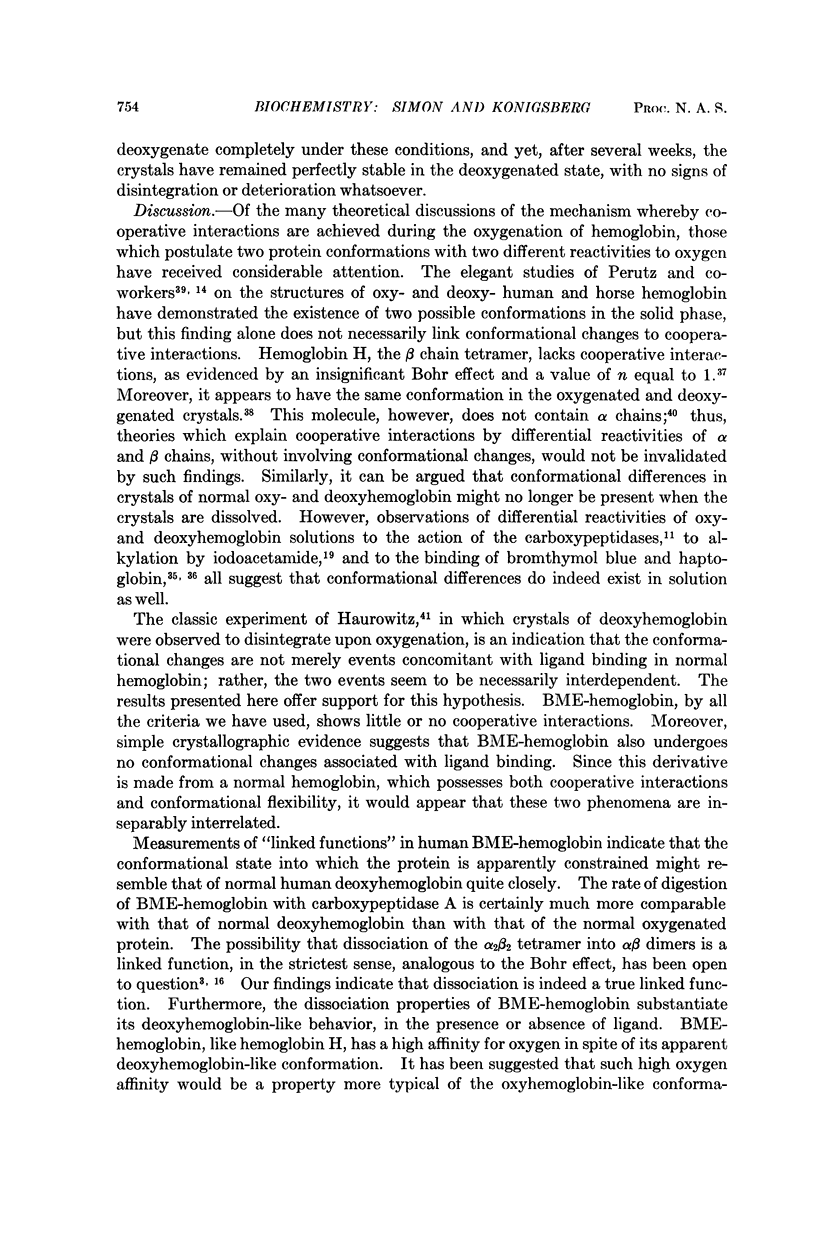Full text
PDF







Selected References
These references are in PubMed. This may not be the complete list of references from this article.
- ANTONINI E., WYMAN J., BUCCI E., FRONTICELLI C., ROSSI-FANELLI A. The dissociation and recombination of subunits of human, horse, and canine hemoglobin. J Mol Biol. 1962 May;4:368–375. doi: 10.1016/s0022-2836(62)80017-5. [DOI] [PubMed] [Google Scholar]
- ANTONINI E., WYMAN J., MORETTI R., ROSSI-FANELLI A. The interaction of bromthymol blue with hemoglobin and its effect on the oxygen equilibrium. Biochim Biophys Acta. 1963 Apr 2;71:124–138. doi: 10.1016/0006-3002(63)90991-0. [DOI] [PubMed] [Google Scholar]
- BENESCH R. E., BENESCH R., WILLIAMSON M. E. The influence of reversible oxygen binding on the interaction between hemoglobin submits. Proc Natl Acad Sci U S A. 1962 Dec 15;48:2071–2075. doi: 10.1073/pnas.48.12.2071. [DOI] [PMC free article] [PubMed] [Google Scholar]
- BENESCH R., MACDUFF G., BENESCH R. E. DETERMINATION OF OXYGEN EQUILIBRIA WITH A VERSATILE NEW TONOMETER. Anal Biochem. 1965 Apr;11:81–87. doi: 10.1016/0003-2697(65)90045-x. [DOI] [PubMed] [Google Scholar]
- BUCCI E., FRONTICELLI C. A NEW METHOD FOR THE PREPARATION OF ALPHA AND BETA SUBUNITS OF HUMAN HEMOGLOBIN. J Biol Chem. 1965 Jan;240:PC551–PC552. [PubMed] [Google Scholar]
- Benesch R. E., Benesch R., Macduff G. Subunit exchange and ligand binding: a new hypothesis for the mechanism of oxygenation of hemoglobin. Proc Natl Acad Sci U S A. 1965 Aug;54(2):535–542. doi: 10.1073/pnas.54.2.535. [DOI] [PMC free article] [PubMed] [Google Scholar]
- Chiancone E., Gilbert G. A. Dissociation of hemoglobin into subunits. I. Oxyhemoglobin: effect of acetic acid. J Biol Chem. 1965 Oct;240(10):3866–3867. [PubMed] [Google Scholar]
- Chiancone E., Wittenberg J. B., Wittenberg B. A., Antonini E., Wyman J. The combination of haptoglobin 2-2 with the oxy and deoxy forms of human haemoglobin before and after digestion by carboxypeptidase A, and with isolated alpha-chains. Biochim Biophys Acta. 1966 Apr 25;117(2):379–386. doi: 10.1016/0304-4165(66)90088-2. [DOI] [PubMed] [Google Scholar]
- Douglas C. G., Haldane J. S., Haldane J. B. The laws of combination of haemoglobin with carbon monoxide and oxygen. J Physiol. 1912 Jun 12;44(4):275–304. doi: 10.1113/jphysiol.1912.sp001517. [DOI] [PMC free article] [PubMed] [Google Scholar]
- GIBSON Q. H. The photochemical formation of a quickly reacting form of haemoglobin. Biochem J. 1959 Feb;71(2):293–303. doi: 10.1042/bj0710293. [DOI] [PMC free article] [PubMed] [Google Scholar]
- GUIDOTTI G., KONIGSBERG W., CRAIG L. C. ON THE DISSOCIATION OF NORMAL ADULT HUMAN HEMOGLOBIN. Proc Natl Acad Sci U S A. 1963 Oct;50:774–782. doi: 10.1073/pnas.50.4.774. [DOI] [PMC free article] [PubMed] [Google Scholar]
- GUIDOTTI G., KONIGSBERG W. THE CHARACTERIZATION OF MODIFIED HUMAN HEMOGLOBIN. I. REACTION WITH IODOACETAMIDE AND N-ETHYLMALEIMIDE. J Biol Chem. 1964 May;239:1474–1484. [PubMed] [Google Scholar]
- KIRSHNER A. G., TANFORD C. THE DISSOCIATION OF HEMOGLOBIN BY INORGANIC SALTS. Biochemistry. 1964 Mar;3:291–296. doi: 10.1021/bi00891a002. [DOI] [PubMed] [Google Scholar]
- Kawahara K., Kirshner A. G., Tanford C. DISSOCIATION OF HUMAN CO-hemoglobin by urea, guanidine hydrochloride, and other reagents. Biochemistry. 1965 Jul;4(7):1203–1213. doi: 10.1021/bi00883a001. [DOI] [PubMed] [Google Scholar]
- Koshland D. E., Jr, Némethy G., Filmer D. Comparison of experimental binding data and theoretical models in proteins containing subunits. Biochemistry. 1966 Jan;5(1):365–385. doi: 10.1021/bi00865a047. [DOI] [PubMed] [Google Scholar]
- MONOD J., WYMAN J., CHANGEUX J. P. ON THE NATURE OF ALLOSTERIC TRANSITIONS: A PLAUSIBLE MODEL. J Mol Biol. 1965 May;12:88–118. doi: 10.1016/s0022-2836(65)80285-6. [DOI] [PubMed] [Google Scholar]
- MUIRHEAD H., PERUTZ M. F. STRUCTURE OF HAEMOGLOBIN. A THREE-DIMENSIONAL FOURIER SYNTHESIS OF REDUCED HUMAN HAEMOGLOBIN AT 5-5 A RESOLUTION. Nature. 1963 Aug 17;199:633–638. doi: 10.1038/199633a0. [DOI] [PubMed] [Google Scholar]
- PERUTZ M. F., MAZZARELLA L. A PRELIMINARY X-RAY ANALYSIS OF HAEMOGLOBIN H. Nature. 1963 Aug 17;199:639–639. doi: 10.1038/199639a0. [DOI] [PubMed] [Google Scholar]
- RIGGS A. The binding of N-ethylmaleimide by human hemoglobin and its effect upon the oxygen equilibrium. J Biol Chem. 1961 Jul;236:1948–1954. [PubMed] [Google Scholar]
- ROELS O. A., HASHIM S. A. Influence of fatty acids on serum cholesterol. Fed Proc. 1962 Jul-Aug;21(4):71–76. [PubMed] [Google Scholar]
- ROSSI-FANELLI A., ANTONINI E. Studies on the oxygen and carbon monoxide equilibria of human myoglobin. Arch Biochem Biophys. 1958 Oct;77(2):478–492. doi: 10.1016/0003-9861(58)90094-8. [DOI] [PubMed] [Google Scholar]
- ROSSIFANELLI A., ANTONINI E., CAPUTO A. HEMOGLOBIN AND MYOGLOBIN. Adv Protein Chem. 1964;19:73–222. doi: 10.1016/s0065-3233(08)60189-8. [DOI] [PubMed] [Google Scholar]
- Riggs A. Functional properties of hemoglobins. Physiol Rev. 1965 Oct;45(4):619–673. doi: 10.1152/physrev.1965.45.4.619. [DOI] [PubMed] [Google Scholar]
- SCHEJTER A., ADLER A. D., GLAUSER S. C. STOICHIOMETRY OF HEMOGLOBIN REACTIONS. Science. 1963 Aug 30;141(3583):784–788. doi: 10.1126/science.141.3583.784. [DOI] [PubMed] [Google Scholar]
- ZITO R., ANTONINI E., WYMAN J. THE EFFECT OF OXYGENATION ON THE RATE OF DIGESTION OF HUMAN HEMOGLOBINS BY CARBOXYPEPTIDASES. J Biol Chem. 1964 Jun;239:1804–1808. [PubMed] [Google Scholar]


